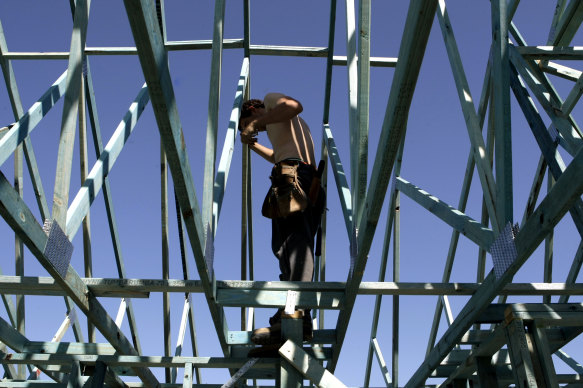By Shane Wright
The nation’s unemployment rate has climbed to a two-year high, driven by troubling signs that the NSW economy is struggling under the weight of the Reserve Bank’s aggressive increases in interest rates.
The Australian Bureau of Statistics on Thursday said the national jobless rate rose by 0.2 percentage points in January to 4.1 per cent. It is the first time the jobless rate has been above 4 per cent since February 2022 with just 500 jobs created during the month.

Large mortgages to buy and build in Sydney are contributing to a slowdown in the state’s jobs market.Credit: Tamara Voninski
NSW was at the heart of the worse-than-expected result, with the state’s jobless rate rising by 0.6 percentage points to 4.1 per cent.
Unemployment in NSW was at a national low of 2.9 per cent in June. Since then, more than 33,000 full-time jobs have disappeared of which 22,000 had been held by women. The jobless rate among the state’s men, which reached a record low of 2.8 per cent in May, has now climbed to 4.2 per cent.
Over the same period, the number of unemployed people has climbed by 54,100 or almost 41 per cent to 186,100, the largest number of people out of work in NSW in two years.
By contrast, the jobless rate in Victoria fell by 0.1 percentage points to 3.9 per cent. It is now the only state with unemployment under 4 per cent with an extra 30,000 jobs created in Victoria since June.
NSW residents are the most exposed to the big lift in official interest rates, with the state’s average new mortgage the highest in the nation at $785,000. The next largest mortgages are in Canberra at $622,000.
Treasurer Jim Chalmers, who said the lift in unemployment was in line with expectations, argued that different parts of the country would be affected by the RBA’s tightening of monetary policy.
“Certainly those parts of Australia which are more exposed to mortgage pressures feel the pain disproportionately when interest rates go up,” he said.
“One of the motivations for our cost-of-living tax cut, one of the reasons why we provided relief right up and down the income scale is because we acknowledge that even people who may be on relatively high incomes still need a tax cut to deal with some of these pressures and one of the most pressing issues that people are dealing with around the kitchen table is the changes to their mortgage repayments.”
Nationally, the number of people out of work climbed to 600,600, the highest since November 2021 as the country was coming out of COVID-related lockdowns.
Total unemployment has climbed by almost 15 per cent over the past year, accelerating over the past nine months, while the number of Australians has increased by 2 per cent. Job creation has been slowing for the past nine months.
The Bureau of Statistics cautioned that there was a large percentage of people out of work in January who said they were likely to have a job within the next month, a pattern that has emerged in the post-COVID period.
Moody’s Analytics economist Sarah Tan said that while the jobs market remained robust, there were growing risks.
“Cracks are emerging in the Aussie labour market. A two-year high in the unemployment reading came as the ranks of the unemployment swelled to a whopping 22,300 people,” she said.
Senior AMP economist Diana Mousina said the jobs figures aligned with other measures of the labour market, such as the number of people applying for advertised jobs, that were pointing to a deterioration.
She said while the Reserve Bank would be unlikely to use its next meeting in March to cut interest rates, a June cut was very possible.
“We see the start of rate cuts sooner than consensus estimates, from around June as we think the economy will show further signs of weakening, including poor GDP growth, low consumer spending and a higher unemployment rate,” she said.
Financial markets reacted to the jobs numbers by ramping up expectations of an interest rate cut by August.
Cut through the noise of federal politics with news, views and expert analysis. Subscribers can sign up to our weekly Inside Politics newsletter.